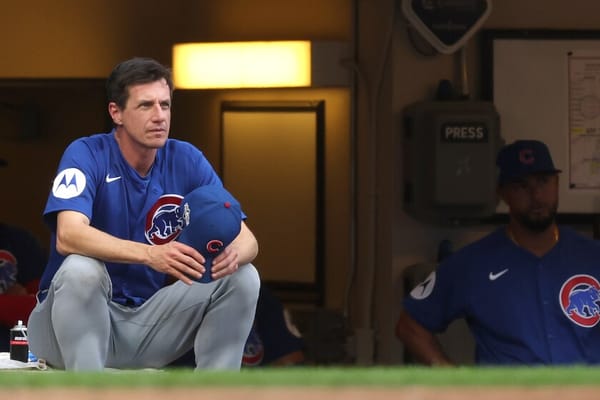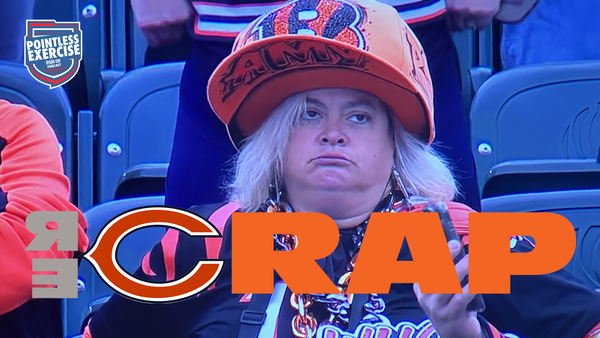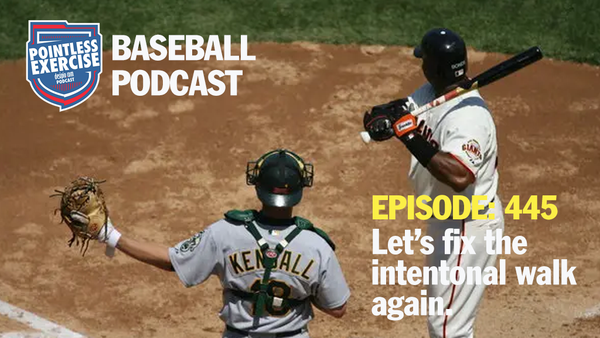Jed's plan is clear, and it's dumb
The Cubs are anticipating the wrong outcome from next year's inevitable lockout
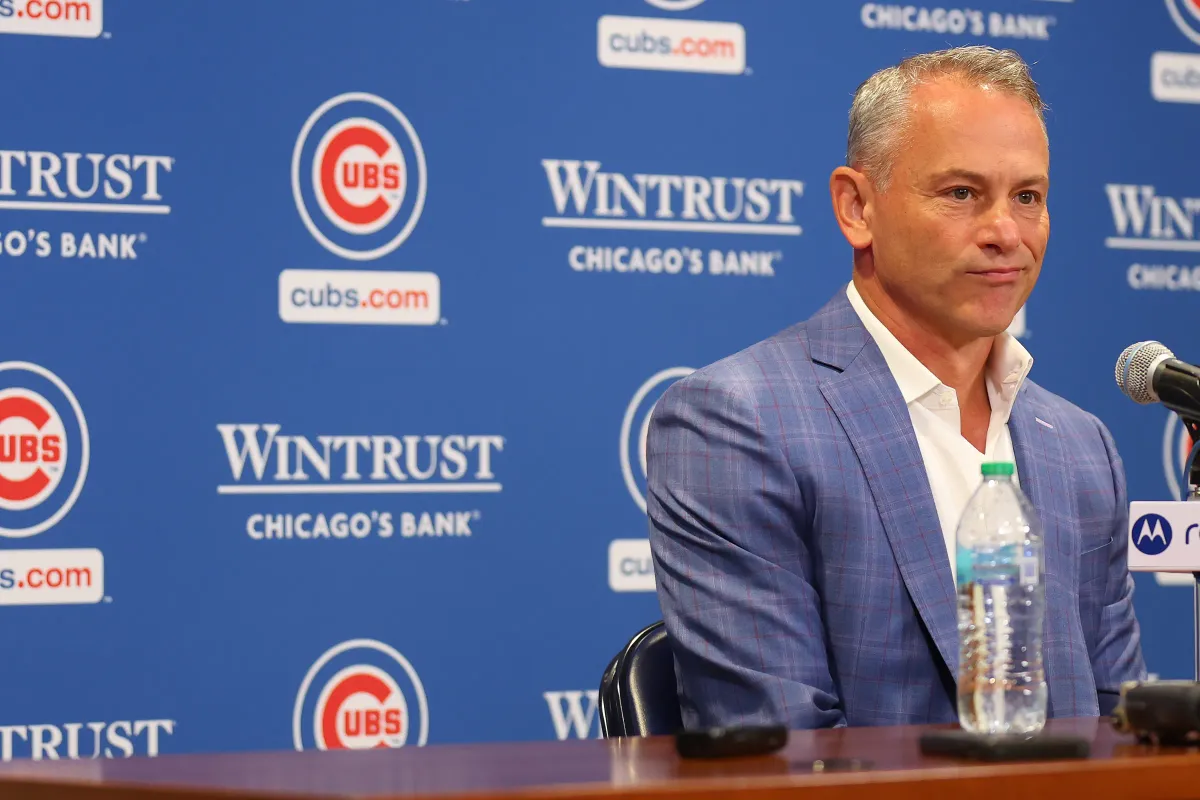
Don't miss the RECRAP on yesterday's Bears win over the Giants

Teams all over baseball have been building rosters the fast few years with one eye focused on what's going to happen between the 2026 and 2027 seasons. Once the final out of the next year's World Series is recorded (probably as a result of Yoshinobu Yamamoto pitching the final 45 innings of the season), the current collective bargaining agreement will expire and the owners will inevitably lock out the players while they attempt to force the players' union into agreeing to a salary cap that there is no need for, other than it would make a bunch of billionaires even richer.
It is not a coincidence that the Chicago Cubs currently have just one player on a long-term contract that extends past next season. That the one player is the slightly better than average Dansby Swanson feels like a bad joke, but that's the only kind the Cubs know how to tell.
To be fair, there are some key players who will still be under team control after next season. Players like Petecrow Armstrong, Michael Busch, Matt Shaw, Miguel Amaya, Cade Horton, Justin Steele and Moises Ballesteros, will all either still be under their entry contracts or arbitration eligible. So it's not nothing. But it's also not enough.
There is no secret that one of the owners who will be pushing hardest for the salary cap is Tom Ricketts of the famed Garbage Family That Owns the Cubs™. So, it's no surprise that his team has adopted the strategy of heading into the lockout with as little committed money as possible.
In their delusional minds, a brand new playing field will emerge after the lockout with tangible restrictions on how much teams can devote to payroll, and the Cubs will have clear books and be poised to take the best advantage of the new landscape. In this fantastical vision of the future, teams like the Dodgers and Mets will be handcuffed because their actual ambitions to win, fueled by paying good players lots of money to come play for them, will push them over the salary cap and force them, over some prescribed period of time, to get back under it. Meanwhile, Jed and Carter will be skipping through the tall grass landing good player after good player with new deals that are far below what the going rate would be in today's system.
It's the best of both worlds for the Cubs. They'll sign good players and they won't need to pay them nearly as much as they would right now.
The only flaw in this grand plan for baseball domination on the cheap is that it's not going to fucking happen.
Yes, I'm sure that the CBA that is inevitably rammed down the players' throats when the lockout is resolved--likely sometime during when the 2027 season should have already been well underway--will put more limits on payroll spending, but it's not going to result in a salary cap. Teams like the Cubs will be disappointed to learn that they have to still pay market value for players, and the "flexibility" of their 2027 roster will mostly result in them having a bunch of holes to fill that they will have no appetite to spend enough to address adequately.
I'm sure this plan was an easy sell to Jed, considering that a) it allowed him to keep his job and b) he remembers how much not planning for extreme changes in a CBA can affect your team-building plans.
When Theo Epstein arrived in that Starbucks back in 2011 and brought Jed back from his exile in San Diego, his plan to quickly build the Cubs into a real contender was to take advantage of some big loopholes in the CBA they were operating under at the time. The Cubs were going to stock up on young talent by drafting top players committed to college baseball teams and then make them large over slot offers to buy them out of those commitments. They were going to spend freely in international free agency and use their big market advantage to buy as many of the top prospects as they could get to sign. And, they were going to trade for players who were entering the final year of their big league contracts so that they could let them leave via free agency and recoup compensation picks for each and every one of them.
It was really smart.
There was also a big flaw in it. The CBA expired at the end of the 2011 season, just weeks after Theo joined the Cubs, and the deal that was signed before the 2012 season blew a huge hole in the side of his grand plan. Teams could no longer spend unlimited money in the draft or international free agency, and players who changed teams during the final year of their contracts no longer had draft pick compensation attached to them.
The Cubs had just one international free agency period with uncapped spending and they used it wisely. They signed two of the top four best prospects, Eloy Jimenez and Gleyber Torres. The 2012 draft was the first with limited salary pools for each team and the results were far from spectacular. The Cubs drafted 40 players and the only ones to ever play in the big leagues were Albert Almora (first round), Pierce Johnson and Paul Blackburn (compensation picks between the first and second rounds), Duane Underwood (second round), David Bote (18th round) and Thomas Pannone (33rd round). When David Bote is the best player from your draft class, it's a bad draft class.
It's telling that the only top free agent the Cubs have been connected to so far this offseason is one of their former prospects, Dylan Cease. Cease is now four seasons removed from the one truly great season of his career, and he's coming off the worst season of his career. Given that the free agent market figures to be really shitty for players this year, you could easily see Cease falling into "pillow contract" territory, where there are no long-term offers for him, so he signs for one year with an option, in an attempt to have a good year and then emerge with a chance to try free agency again next year...should there actually be one.
I would be amazed if the Cubs sign a single player this offseason to a deal of more than one guaranteed year. They will sign players, but they are all going to be for one season, or one season with a team option and a buyout for 2027.
There will be no contract extension talks for soon-to-be free agents like Seiya Suzuki, Nico Hoerner or Ian Happ (well, at least that's one positive.) They might revive extension talks for Petecrow, but they'll only do it if they can guarantee themselves a long-term bargain, and I don't see Petecrow signing that. After all, his family's wealth is built on those still lucrative residual checks for both parents from NBC's Heroes. They must still be in the $70 or $80 a month range. Each!
Maybe the market will fall to the Cubs, so they can at least kind of patch their holes for next season. Other than the Dodgers (who figure to spend real money to add at least one good outfielder) and the Mets, it's really hard to find any team who is willing to spend this offseason.
The offseason market before any CBA negotiation is always shit for players, and this not only will not be an exception, it figures to be even worse than normal.
The Cubs could spend a shitload of money this offseason and still be tucked safely under their precious luxury tax threshold, and they could likely clean up, but they don't want to do that. They're not interested in doing it.
They are convinced that starting in 2027 they'll be able to sign players for a fraction of what they cost today. Even though there's zero reason to actually believe that will happen.
Even then, the Cubs could sign Kyle Tucker to a $40 million per season deal, and their total payroll commitment for 2027 would rise to just $98 million bucks. That's it. But even that is exaggerated, because that figure includes mutual options for Matthew Boyd, Carson Kelly and Colin Rea that there's no reason to believe the Cubs will actually pick up. So, instead of actually paying those players a combined $30 million in 2027 ($15M for Boyd, $7.5M each for Kelly and Rea) they will instead pay a total of $3.5 million for those three to leave.
That means that if the Cubs signed Tucker for $40 million a year (and given the market, his actual price tag will surely be closer to $30 million per), their total payroll commitment for 2027 would be $71.5 million.
Even when you add on the salary arbitration deals for the young players who will be eligible and the ones whose contracts can be renewed by the team for whatever they want, their total commitments would likely still be under $110 million. Which means that without that not-gonna-happen $40 million for Tucker, it's about $70 million.
This for a team that has a half billion dollars of revenue each year.
The Cubs could spend real money this offseason and still be well positioned for whatever the CBA may reap.
But they're not going to even bother to do that.

On Friday, all of your Christmas shopping angst will be alleviated, because you can thrill everyone on your list by buying them copies of my new book, "The Immortals - The 2016 Chicago Cubs, who made professional sports' longest wait worth every minute."
It will be available on Amazon starting November 14. You will be able to buy a paperback, or if you want to really be fancy, a hardcover version.
And if that's not enough, a week later, November 21 another book by me will drop, "Great Until It Wasn't - The highs and lows of the 2003-2004 Cubs."
I know, I know. Try to contain your excitement.
Both books follow the same basic format. They are full of columns from those seasons, updated with side notes (footnotes, only in the margins to make it easier to zip back and forth) to add some context, hindsight, or in many cases to allow me to make fun of things I wrote.
"The Immortals" features columns from 2014 when the Cubs hired Joe Maddon, 2015 and the entirety of the 2016 season.
"Great Until it Wasn't" covers the time from January 2023 when Dusty Baker was introduced to Cubs' fans at the Cubs Convention, all the way through the ill-fated homestand that ended the 2004 season. Hey, at least Chip got fired on that final day. There is also some brand-new content, including a rewatch of game six against the Marlins--one that made me super mad all over again, 22 years later.
Over the next couple of weeks I'll run some excerpts from each book, starting today with a prescient column from May 7, 2015.
Excerpt from The Immortals
The Cardinals Don't Matter - May 7, 2015
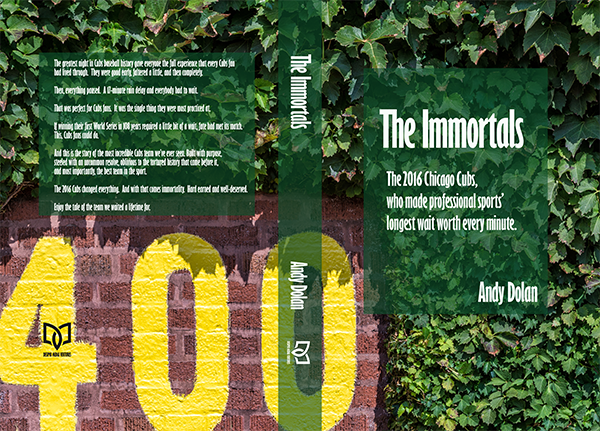
The Cardinals don’t matter
May 7, 2015
Major League Baseball saw fit to pair the Cubs and Cardinals up seven times in the first six weeks of the season, including a rare four-game set at Bus(c)h Stadium this week.
Much angst has been had about how the Cubs' struggles to hold a lead in the first three games in St. Louis reflect on whether or not the Cubs match up with the Cardinals.
I’m here to tell you this. It doesn’t matter, right now. The Cardinals don’t matter, right now.
St. Louis is off to their best start since Nathan Bedford Forrest was playing for the team. The Cubs win last night snapped an eight-game winning streak for the Cardinals and they are 20-7, and already 5.5 games clear of the Cubs. This would all be meaningful, if we thought it really mattered.
The Cubs team that’s on the field right now is not the team that will be hopefully swinging elbows with the big boys late in September and (dare we dream) October.
The names might largely be the same, but Jorge Soler, Kris Bryant and Addison Russell will all be older and wiser and much more comfortable with about 100 more big leagues games under their belts. They haven’t even combined for 100 big league games yet.
You would certainly expect that Theo and Jed will have addressed that shitstorm of a middle relief corps, and hopefully by then the starters are consistently going deeper into games, taking some of the load off of those overmatched guys in the first place. Sure, every game matters. A win in April or May is just as important as one later in the season, so by definition, these games do matter. But they don’t carry any other significance.
There are no lasting statements being made.
The Cardinals are a good team on a hot streak. The Cubs are a good team still trying to figure stuff out. It’s May.
St. Louis is not a great team. They’re still pretty damned good, but this is no juggernaut[1]. That said, they are clearly the best team in the NL Central and chances are they’re going to cruise to a division championship[2].
The teams the Cubs will be battling it out for a playoff spot are most likely the Mets (the Nats seem to be getting their shit together now), Pissburgh, Giants, Padres and maybe the Marlins. The Cubs have to finish ahead of four of them.
I’m like everybody else, I get more aggravated during games at Bus(c)h Stadium than anywhere else the Cubs play. I hate that place, I hate that team and I hate those fans. If the Cubs win today behind Jake Arrieta[1] they’ll be 3-3 against the Cardinals so far this season. But at this point 3-3 or 2-4 doesn’t really matter.
They didn’t. ↩︎
That’s not to say that we haven’t seen some things that in the long run, and in the big picture, do matter.
It’s been impressive to see the Cubs batter Cardinals' starting pitching.
Nobody has done much damage to them so far this year, but the Cubs have scored 19 runs so far in the series.
Joe Maddon’s sixth inning ejection matters. DJ “Sam” Reyburn’s strike zone was an amoeba last night, but especially when Soler, Bryant and Russell were up. Joe sent a message.
These three know the strike zone better than most veterans do. So when they spit on a pitch, don’t just assume they gave up on it. They know it’s a ball. It’s a ball. Yadi Molina can set up three feet outside the not budge an inch when the ball hits his glove, but that doesn’t make it a strike.
And it didn’t stop the Cubs from having fun. At one point, Bryant fielded a grounder and Starlin Castro mimicked his throw to first from right behind it. It was funny. It was dumb. It was harmless. That it happened in the joyless buzzkill of Bus(c)h Stadium made it that much better. You could hear the old white people “tsk tsk-ing” Starlin from the stands. “Our boys, I say, I say, our boys, wouldn’t stoop to such foolhardyness! There is no place for those shenanigans on the Baseball Club of Saint Louis, no sir.”
Well, good. Because guess what? We’re going to enjoy this our own way. We’re not going to golf clap a sac bunt in the third inning and act like it proves we are “true fans of the game.”
I’m trying to convince Kris Bryant that when (if) he finally starts hitting home runs, that instead of a Luis Valbuena-esque bat flip, that he stand at home plate, watch the ball land in the stands, rip his jersey off, buttons and all, drape it over his bat, set it on fire and round the bases with it over his head like it’s a torch.
And anyway, maybe synchronized fielding is a new undervalued thing to exploit?
So, the point to this long, rambling missive is this. These are just four games in a random week in May. The Cubs are figuring this stuff out on the fly. They don’t need the approval of the Cardinals that they’re doing things the right way. It’s going to be an uphill battle all season to take a team this young and get to the playoffs.
But if they do it, and if that run ends up with a series that starts at Bus(c)h Stadium, well, THEN it will matter. And if that happens, chances are the Cardinals aren’t going to like what they see.[1]
This, dear reader is what we call foreshadowing. ↩︎
It’s coming. It’s not a matter of if, but when. Maybe this year, maybe not.
But right now, it’s just another game off the schedule and another page off the calendar. The Cubs have bigger things to concern themselves with than the Cardinals.

Here's what it looks like in the book, so you can see those fancy side notes.



